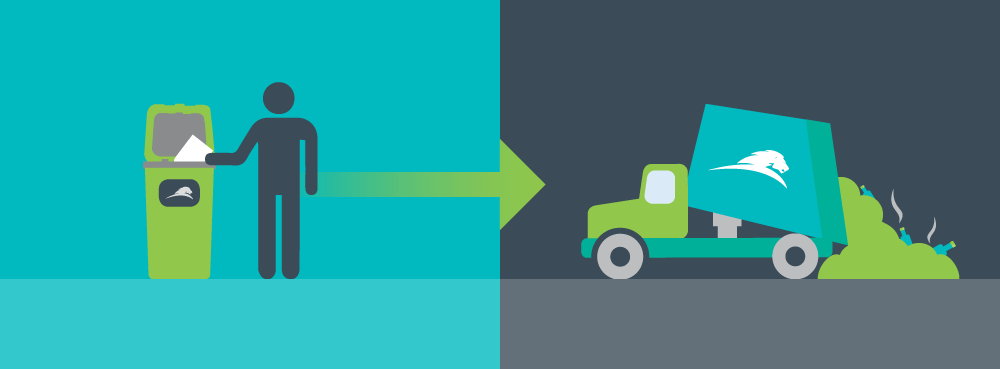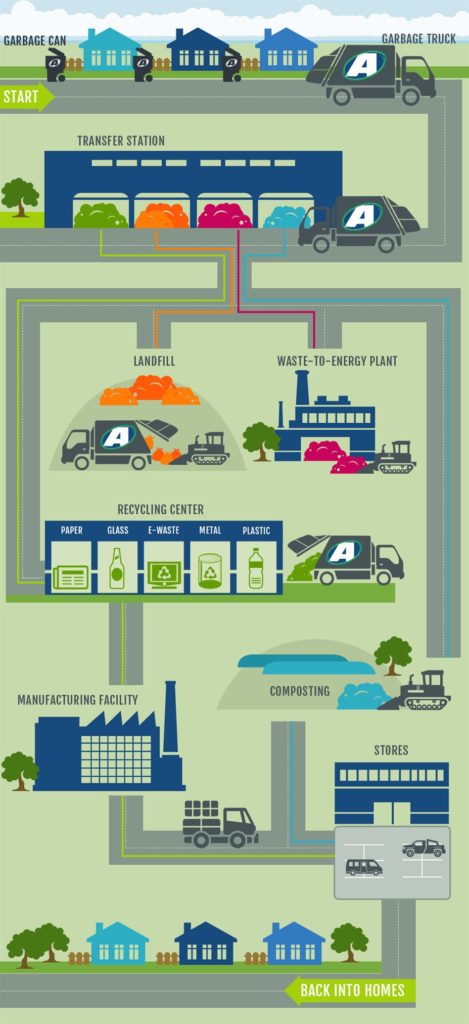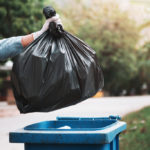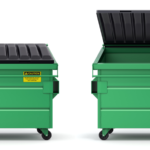In the world we live in today, we think of garbage disposal as one of our daily chores.
The trash bags pile up over the day as you throw out plastic bags, soda cans, food, etc.
When it has filled up to the brim, you then take it out to the garbage can. Then when that has piled to the top, you take it out to the street.
Finally every week, the garbage truck drives by, takes away the trash, and takes it to the dump, right?
Well it’s a bit more complicated than you might think.
Where does it go?
Americans generate about four pounds of garbage per day. That translates into 210 million tons per year for the population of the U.S.
But where exactly does all the garbage go after it’s taken away every week?
It’s just thrown out to the dump, right?
Well, not quite.
Transfer Stations
The garbage is actually taken to a transfer station.
A transfer station is an industrial facility where solid waste is sent to be staged before heading to its final destination, such as a landfill or waste-to-energy facility.
Transfer stations help keep solid waste moving, helping to maintain clean and sanitary conditions. This will help keep things clean like homes, businesses, the community, and the local environment.
The most significant benefits of solid waste transfer stations for members often include:
- Increased fuel savings
- Reduced air pollution
- Minimized traffic congestion
- Convenient drop-off locations open to the public
- Improved safety at landfills
- Encourages adequate screening of items before garbage disposal
- Reduced amounts of solid waste materials on commercial sites
Transfer stations are really useful for organizing the trash we throw away, but where does the garbage go after this?
Well, the garbage can go to four different places depending on the contents of the trash, which are:
- Landfills
- Waste-to-energy plants
- Recycling centers
- Composting
Let’s explore more in-depth about these four areas.
Landfills
A landfill site, also known as a dump, garbage dump, or dumping ground, is a site for the disposal of waste.
Landfills are the oldest and most common form of garbage disposal.
Although the systematic burial of the waste with daily, intermediate and final covers only began in the 1940s.
But there is way more to a landfill than just a place where garbage goes.
There are actually many types of landfills, such as:
- Municipal Solid Waste Landfills (MSWLFs) – Specifically designed to receive household waste, as well as other types of non hazardous wastes.
- Bioreactor Landfills – A type of MSWLF that operates to rapidly transform and degrade organic waste.
- Industrial Waste Landfills – Designed to collect commercial and institutional waste. This is often a significant portion of solid waste, even in small cities and suburbs.
- Construction and Demolition Debris Landfills – A type of industrial waste landfill designed exclusively for construction and demolition materials. This consists of the debris created during the construction, renovation and demolition of buildings, roads and bridges. C&D materials often contain heavy materials, such as concrete, wood, metals, glass and salvaged building parts.
- Coal Combustion Residual Landfills – An industrial waste landfill used to manage and dispose of coal combustion residuals (CCRs or coal ash).
- Hazardous Waste Landfills – Facilities used specifically for the garbage disposal of hazardous waste. These landfills are not used for the disposal of solid waste.
These are all the many different types of garbage disposal that goes on in these different landfills.
Each of these landfills continue to grow as more people throw away trash in our everyday lives. But where else does our garbage go?
Waste-To-Energy Plants
These plants are a garbage disposal system that turns the trash we throw away into electrical energy using steam in a boiler.
Many of these plants can reduce 2,000 pounds of garbage to ash weighing only about 300 to 600 pounds. This can reduce the volume of waste by about 87%.
The most common type used in the U.S. is the mass-burn system. This is where the trash is burned in a large incinerator to produce electricity.
The process of generating electricity in a mass-burn waste-to-energy plant has seven stages:
- Waste is dumped from garbage trucks into a large pit.
- A giant claw from a crane grabs the waste and dumps it into a combustion chamber.
- The waste is then burned, which will release heat.
- The heat turns water into steam in a boiler.
- The high-pressure steam turns the blades of a turbine generator to produce electricity.
- An air pollution control system removes pollutants from the combustion gas before it is released through a smoke stack.
- Finally, ash is collected from the boiler and the air pollution control system.
These plants however are more commonly used in European countries and Japan. This is due to there being less area for them to have landfills.
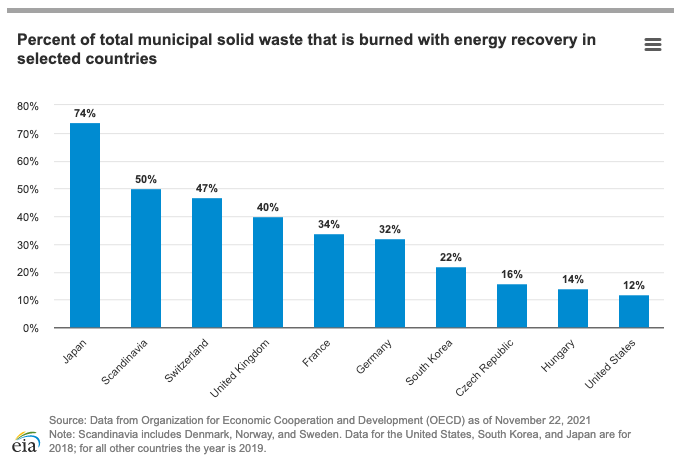
Waste-to-energy plants are a great and helpful way to use the trash we throw away as a resource for the energy we use each day.
Recycling Centers
These centers are used to put any recycled materials into an organized building and are actually put back in the marketplace for customers to purchase them again.
Surprisingly, many recycling centers don’t take certain plastics such as:
- Greasy pizza boxes—if the box isn’t greasy it can be recycled. Otherwise, you can just recycle the side of the box that isn’t greasy.
- Single-use paper cups, because most are lined with a film of polyethylene (you can recycle the plastic lid separately).
- Plastics labeled with the numbers 3, 6, and 7 (though some labeled #7 are compostable).
- Plastic bags should not be put into your recycling bin, however there are some centers in cities that will take your plastic bags, but they still need to be separated.
When the recycled garbage is put in these centers, they’re then organized into different categories like newspapers, plastics, cans, etc.
Next, they clean the recycled items using cleaning systems in their facilities.
Finally, manufacturers come to the recycling centers and buy back the recycled goods.
Then they use them again in their stores to sell back to customers.
However, this is also just one of the ways to get rid of the trash.
Composting
Composting is simply the process of recycling decaying organic material like food scraps or dry leaves.
Many of the effects from composting are really good for us and our environment. Here are some reasons why we should compost more:
- Reduces the waste stream – Food scraps and garden waste is 28% of what we usually throw away. Not only is food waste a significant burden on the environment, but processing it makes it more costly.
- Cuts methane emissions from landfills – When compostable waste goes to a landfill, it gets buried under huge amounts of trash. This cuts off a regular supply of oxygen for the decomposers.
- Improves soil health and lessens erosion – Composting can make the soil much more rich which brings more worms or fungi.
- Conserves water – Water is essential for major things such as agriculture which uses 80% of the water in the U.S. By using compost to foster healthier soil, farmers don’t have to use as much water. This way, they can still have higher yields compared to farming with degraded soil.
- Reduces personal food waste – Consumers are responsible for a staggering amount of wasted food. An average American family of four throws out about $150 worth of food per month.
Composting can do a lot from keeping our water safe for our farmers to slowing the effects in our environment.
To Conclude
Garbage disposal is always something that is a part of our culture. The question is how we decide to get rid of our waste.
The trash service industry has many guidelines in each area of the U.S. This means that the community has to follow to ensure a better environment to live in.
In conclusion, it’s really good to know what your guidelines are in your community. Knowing this will help you make a more informed decision of how you should throw away your garbage.

